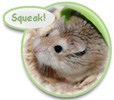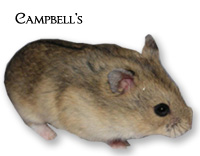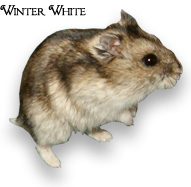Hybrid Dwarf Hamsters
From Hamster Central WIKI
The second meaning of "hybrid" is crosses between populations or breeds of a single species. This second meaning is often used in plant and animal breeding.
Of the five species of hamsters kept as pets, only the Winter White Hamster (WW) and Dwarf Campbells Hamster are able to interbreed and successfully produce live offspring. Hybrids are more then often produced do to casual breeding from inexperienced owners and because of incorrect identification of the two. Pets store are known to be one of the main culprits.
In 2004-2005 four new colors of Winter White appeared - mushroom, orange, mandarin and brown. There was much debate as to whether they were pure or hybrids as they exhibited characteristics more akin to WW however these colors had never before been seen anywhere in pure WW.
In 2006 it was established that some breeders in Holland had indeed crossbred Dwarf Campbells Hamster and Winter White Hamster to obtain a wider range of WW colors. The new colors had been bred to pure WW colors making these lines hybrid.
Hamsters are distributed in Europe for the commercial pet trade and these hybrid animals were sent to other European countries including the UK and Germany and as far afield as Singapore. In the hands of the commercial breeders these hybrid lines have found their way into pet shops.
Even after many, many generations of WW breeding if there is one hybrid in a line, no matter how far back it is, these animals are hybrids. Once a line is hybridized it is forever a hybrid line. You cannot breed it out. Problems arising in the hybrid lines are common. Health problems include head tilt - a neurological disorder, diabetes formerly only common in Campbell's but not WW and glaucoma, an eye condition as well as a decrease in fertility. There is also danger to the mother due the pups size when giving birth to hybrid pups.
It is important that breeders keep accurate records as sometimes hybrid colors do not show until future generations. It seems likely that hybrids will continue to be bred by commercial dealers for their attractive colors. The new color WW were banned from the NHC shows due to their being known hybrids. Breeding Hybrids is discouraged among hamster enthusiasts. Due to the geographical distribution in the wild, these animals would not interbreed. There is the danger of a decrease in pure blooded Campbell's and Winter Whites in the captive hamster population.
Dwarf Campbells Hamster and Winter White Hamster look quite similar to the inexperienced eye. If you are concerned about making sure you have the same species do not rely on pet shops to correctly ID them as they usually don't know. You may want to find an experienced breeder in such cases.
- Measures approx 3¼ -4¾ inches (10-12cm) in length.
- Body appears flatter and oval shaped.
- Eyes are roughly equal distance from nose and ears.
- The dorsal stripe on the back is grey-black and thinner.
- Normal colors is paler in color and is more brown-grey
- Measures up to four inches (10cm) in length
- Body appears more bullet shaped.
- Eyes usually larger and bolder , placed closer to the ears
- The dorsal stripe on its back is thick and jet black.
- Longer head and a rounded nose.




